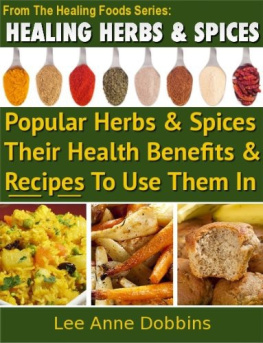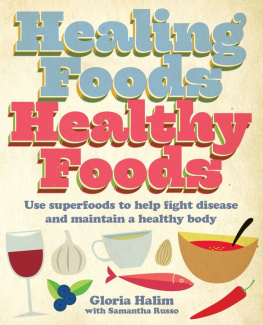HEALING
SPICES
HEALING
SPICES
50 WONDERFUL SPICES, AND HOW TO USE THEM
IN HEALTH-GIVING FOODS AND DRINKS

KIRSTEN HARTVIG

CONTENTS
INTRODUCTION
I have often wondered why nations fought such long wars over nutmeg, cloves, vanilla and black pepper. It seems disproportionate to have risked lives just for an added flavour. Had it been food wars, not spice wars, it would be easier to understand. However, spices are much more than wonderful taste supplements.
They also provide concentrated, powerful medicines that can enhance health and vitality, treasures that ancient cultures knew well and that modern society is now rediscovering through science and research.
ABOUT THIS BOOK
The spices described within this book come from all over the world. Many are related and belong to the same genus or botanical family for example, chillies and paprika; ginger, galangal, turmeric and zedoary; and all the peppercorns. Most originate from tropical equatorial regions and dry mountainous areas, though there are some notable exceptions such as salt, which is a mineral that comes (essentially) from the sea, and juniper, which is common throughout the Northern Hemisphere.
As you read the spice profiles that follow, you will discover the history, geography and science of the ingredients stored in your spice cupboard, and learn where to buy them, how to store them and how best to utilize them as both flavourings and medicines. I also hope to introduce you to spices that you may not have encountered before: perhaps melegueta pepper, kaffir lime leaves or sansho?
With a choice of nearly 100 recipes from around the world as well as in-depth profiles of 50 key spices, you will learn how to create a whole range of dishes, preserves, spice blends, beverages and cordials. All the spices that I feature are available either in supermarkets, health food stores, Asian supermarkets or from online suppliers. Some, such as turmeric and galangal, are also becoming much easier to find fresh as interest in exotic ingredients has increased their demand. The ingredients I have chosen in my recipes are not expensive, although I always encourage the use of organic ingredients and locally sourced, seasonal produce. As the world shrinks and multiculturalism takes root, our food choices grow more interesting, allowing us to explore other cuisines and dare to experiment to make them our own.
In writing Healing Spices, my aim has been to produce a complete, easy-to-use, practical guide to the flavoursome world of spices, and to tell you all that you need to know in order to release their potential for improving your wellbeing. The spices that I include have had a worldwide impact on traditional and contemporary cooking, and each (used correctly) has the ability to transform a dish from the ordinary to the extraordinary. Some of my choices, such as garlic, horseradish and cocoa, are not spices by definition, but they are included here as significant members of an expanding palette of ingredients essential to bring out the flavour and give identity to todays international cuisines.
In a world that is awash with taste-alike processed foods and synthetic flavourings, I hope that this book will inspire you to experiment with, and extend, your spice range, and to deepen your understanding of the wisdom of cultures for whom the use of spices has long been an essential part of the fabric of daily life.
ABOUT SPICES
Spices are the aromatic, fresh or (more commonly) dried barks, roots, berries, buds, fruits, leaves, grains and seeds of a variety of trees, shrubs and plants, and have been treasured for their healing and taste-enhancing effects since the earliest times. The ability of spices to transform bland foods to attractive meals and medicines is well illustrated in traditional cuisines all over the world.
Cloves from the Moluccas; cinnamon from Sri Lanka; pepper from the Malabar Coast; chillies from Peru: for over 4,000 years, spices from five continents have been used to bring recipes to life, to enhance beauty and vitality, and to treat and prevent diseases. They have enriched our language and our folklore, excited our senses and inspired us to explore new culinary vistas.
Spices have also played a central role in the development of world trade in our long search for them we have discovered new lands, fought fierce wars, earned and lost fortunes, and changed political destinies. Today, nearly 2 million tonnes of spices are grown, processed, traded and sold each year around the world.
The word spice comes from the French pice, which itself derives from the Latin word species, meaning type, specific kind or ware. Most dictionaries define a spice as something aromatic or pungent, used alone or in combination with other ingredients to flavour food, but it also means something that adds interest and excitement. Spices are mostly dried, concentrated substances, used primarily for seasoning and are best added at the beginning of the cooking process as heat brings out the richness of their full flavours.
In cooler parts of the world, salt is the most common indigenous spice, used for centuries to give or improve flavour, and to preserve and cleanse. In hotter regions, and especially in the tropical regions that lie either side of the equator, the sun has more power, plants grow faster, flavours are stronger and food goes off more quickly, so the need for effective preservatives and disinfectants is greater. Perhaps this, in part, explains the fact that most of the spices we value so highly today (cinnamon, pepper, ginger, vanilla, nutmeg, cloves and chillies) are native to the tropics of Asia, Central America and Africa.
In a multicultural world where what was once considered foreign and exotic has become commonplace, it is easy to forget that most spices come from plants native to very particular local environments and were once completely unknown outside these areas. A small group of remote tropical islands (the Moluccas, or Maluku, in Indonesia) was the birthplace of nutmeg and cloves, once the worlds most treasured spices, and the Mediterranean provided a suitable cradle for many of the aromatic spices now popular worldwide, such as cumin and coriander, fennel and fenugreek, poppy, nigella and aniseed.
As the pace of world trade and population migration increased, the Americas and the Caribbean islands became melting pots for many disparate cooking traditions, mixing the indigenous Aztec and Inca cuisines with those of European conquerors and African slaves. Spices from Asia were planted in New World colonies and New World spices were introduced to countries in the Mediterranean and the Far East.
Spices are now cultivated in many more parts of the world, particularly in Asia. Individually and in mixtures, they are an essential and valuable part of the Earths nourishing and healing ability: creating balance, giving strength and enhancing the health and immunity of the worlds inhabitants.
THE ORIGIN OF SPICES WITHIN THIS BOOK
INDIA/HIMALAYAS/SRI LANKA
| ajowan | cardamom | ginger | lemongrass |
| amchoor | cinnamon | jaggery | pepper |
| black cumin | curry leaf | kokum | zedoary |
AMERICAS/CARIBBEAN

















